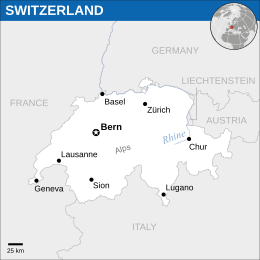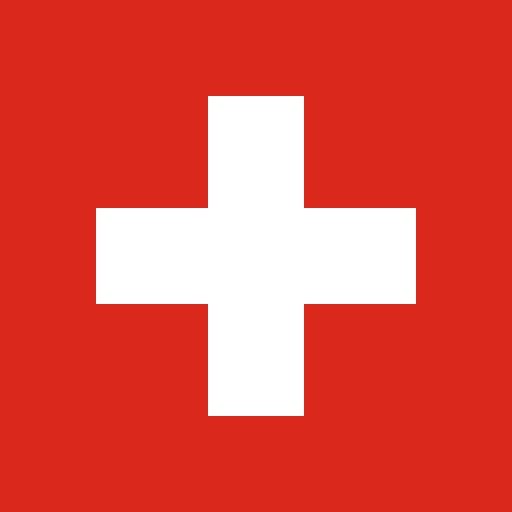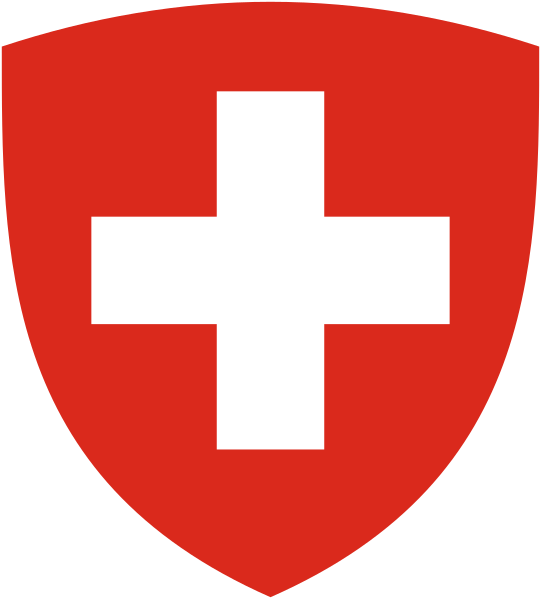| Swiss Confederation Confédération suisse (French) Confederazione Svizzera (Italian) Confederaziun svizra (Romansh) Confoederatio helvetica (Latin) | |
|---|---|
 | |
| Capital | None (de jure) Bern (de facto) |
| Largest city | Zürich |
| Official languages | German, French, Italian, and Romansh. |
| Dominant mode of production | Capitalism |
| Government | Federal assembly-independent directorial republic |
• Federal Council | Viola Amherd (President) Karin Keller-Sutter (Vice President) Guy Parmelin Ignazio Cassis Albert Rösti Élisabeth Baume-Schneider Beat Jans |
• Federal Chancellor | Viktor Rossi |
| Area | |
• Total | 41,285 km² |
| Population | |
• 2021 estimate | 8,703,405 |
The Swiss Confederation, also known as Switzerland, is a landlocked mountainous country located in the heart of Europe bordered by Germany, France, Italy, Austria and Liechtenstein. It is known for its banking system as well as being supposedly neutral; not involving itself in any foreign war since 1815. However, this neutrality has not prevented it from engaging in imperialism.
History
Napoleonic era
The French Revolution, that erupted towards the end of the 18th century, inspired the Swiss bourgeoisie to begin revolutionary action to put an end to feudalism in Switzerland. Disturbances took place in Geneva, Valais, and Vaud in 1792, whilst in Basel the Rauracian Republic was formed, but was swiftly annexed by France in May 1793.[1]
The French Army entered Switzerland in spring 1798 and captured Bern on March 5; leading to the proclamation of the Helvetic Republic on April 12 in Aargau. The new Swiss state had a constitution modelled after the French constitution of 1795, making Switzerland a centralized, unitary state. The defensive agreements concluded with France involved Switzerland in the Napoleonic Wars, causing Switzerland to become a battleground during the War of the Second Coalition.[1]
A struggle developed in 1802 between the unionists and the federalists and on February 19, 1803, Napoleon issued the Act of Mediation which restored the old pre-1798 system of Switzerland with some changes. Following the defeat of Napoleonic France, the Act of Mediation was repealed and Switzerland declared on December 29,1813 its intent to observe strict neutrality. This decision was included in the new constitution drafted in September 1814 and ratified by the diet in August 1815. The Congress of Vienna in 1815 also recognised Swiss neutrality as well as granting Switzerland the lands of Valais, Geneva and Neuchâtel.[1]
Industrialisation
In the 1830s the liberal bourgeoisie began agitating to eliminate feudal relations and centralize the state which put them at odds with the clerical faction. Between 1843 and 1845 seven Catholic cantons established a reactionary bloc, the Sonderbund, which in 1847 provoked a short civil war in which the federal government was victorious. The victory of the bourgeoisie was affirmed in the 1848 constitution which established a centralized federal state and its power was extended by the 1874 constitution; this centralization allowed for the swift establishment of capitalism.[1]
Switzerland's role as a middle man in international trade allowed for the swift accumulation of capital which helped it usher in the industrial revolution. Light industry expanded substantially in the 40s and 50s, and agricultural production became more specialized allowing for butter and cheese to become important exports. Between 1825 and 1874 the length of the railroad system increased from 25 km to 1,500 km and continued to expand, increasing freight and passenger travel in Switzerland rapidly, and in 1898 the railroads were bought by the state from the private sector. During this time Switzerland also became a hub for political refugees and several sections of the First International were created in the country.[1]
At the end of the 19th century several new industries established themselves in Switzerland such as machine building and between 1888 and 1910 the number of persons employed in industry rose from 543,000 to 811,000, helped by an influx of foreign workers. By the beginning of the 20th century monopoly capitalism had become firmly entrenched with Swiss Assets abroad in 1914 amounting to 7.5 bn francs. The first working class disapproval began to make itself known at this time, the largest of which being a general strike in Zürich in 1912, this pressure allowed for some minor protections for workers to be implemented in 1911.[2]
World Wars
When the First World War began in 1914 Switzerland immediately reaffirmed its neutrality and took advantage of the conflict to reap profits by selling war material to both sides. However, the standard of living for workers declined significantly in the war years with an almost 30% drop in wages leading to an increase in strikes in 1917. During the war, Switzerland also became a hub for socialist conferences with the Zimmerwald left being directed in part by Vladimir Lenin.[2] The October Revolution helped grow the strike movement in Switzerland and from November 12 to 14, 1918, a general political strike took place; involving about 400,000 persons, which was supressed by the army. However, the government did give in to some demands such as proportional representation in the assembly and a 48-hour working week.[3]
The Swiss government briefly established relations with the Soviet Union in March 1918 and a Soviet mission was sent in June but it was expelled on November 12,1918 under the false charge that the Soviets were taking part in Swiss working class demonstrations; the Swiss then broke off diplomatic relations with the Soviet Union which would not be resumed until 1946. Switzerland joined the League of Nations in 1920 with the stipulation that it would not involve itself with military matters. In 1923 it established a customs union with the microstate of Liechtenstein leading Switzerland to handle most of the states foreign affairs from then on.[3]
In 1931 Switzerland was gripped by the Great Depression leading to an economic crisis in which the class struggle was exacerbated; leading to strikes which were brutally repressed. The suppression of the socialist movement and a wave of arrests of communists followed, whilst in contrast the government allowed fascist groups such as the National Front to set up and grow. In 1936 the Swiss economy upsurged due to an increase in exports to neighbouring Nazi Germany and Fascist Italy along with a refusal to take part in sanctions against the fascist powers. Swiss trusts such as Nestlé continued to expand abroad in this time whilst the reformist Social Democratic Party of Switzerland (SP/PS) influenced the trade unions to side with the bourgeoisie and establish a labour peace with an agreement to not strike.[3]
During the Second World War, beginning in 1939, Switzerland had a complex relationship with the Nazi regime since while officially neutral, Switzerland had economic and political ties with Nazi Germany. The Swiss government maintained a policy of strict neutrality during the war, but it also profited from trade with the Axis powers and had a his tory of accepting stolen Jewish assets.[4][5] Additionally, the Swiss government's policies towards Jewish refugees were often discriminatory, with strict quotas and regulations that made it difficult for Jewish refugees to enter Switzerland.[6] The Swiss government's policy of neutrality during the war can also be seen as a way to protect its own economic interests, rather than a political stance against the atrocities committed by the Nazi regime, which is an example of capitalist system's tendency to prioritize profit over moral considerations.[7]
Cold War
Swiss industrial capacity rose during the war, as did the gold reserves in the Swiss National Bank which rose from 2.2bn francs in 1940 to 4.8bn francs in 1945. A large part of this growth was as a result of the exploitation of workers whose standard of living in the war years declined by 10-13% which led to strikes in 1946-47, which granted a few minor concessions such as a small old age and disability pension in 1947 and a minimal decrease in the working week from 48 hours to 47.5 in 1950 (later reduced to 43.2 hours in 1975). In the 1950s, the backdrop of the Cold War led to a suppression of the socialist movement in the, led by the Swiss Party of Labour, when an occupational blacklist known as the Berufsverbot was introduced. The Berufsverbot lasted until the 1970s and whilst active it allowed the growth of reactionary nationalist groups in the country.[8]
During the Cold War Switzerland was firmly tied to the interests of the West and imperialism although it still pursued relations with the socialist camp and promoted trade and scientific collaboration with the East. Switzerland joined the Organization for European Economic Cooperation in 1948, the European Free Trade Association in 1959, and the European Council in 1963. In 1972, Switzerland signed an agreement with the European Economic Community (EEC), the precursor to the EU, concerning the reciprocal elimination of tariffs but refused to join the EEC due to its official neutrality. Despite joining the United Nations late, Switzerland was active in its organisations throughout the Cold War as well as signing the Nuclear Test-Ban Treaty in 1963, the Nuclear Non-proliferation Treaty in 1969 (ratified 1977) as well as the Biological Weapons Convention in 1972.[8]
Switzerland was one of the last countries in Europe to give women the right to vote aside from Liechtenstein, Vatican City and to some extent Portugal, which also put it behind most of the rest of the World as well.[9] The male population only voted in favour of women's suffrage at the federal level on February 7, 1971, which allowed the first women into parliament on October 31 when 11 women (5.5%) were elected. A previous referendum on February 1, 1959 rejected the proposal by 654,939 (67%) no vs. 323,727 (31%) yes and the successful vote in 1971 only passed it by a vote of 621,109 (66%) yes vs. 323,882 (34%) no. At the cantonal level the right to vote varied by canton with some cantons allowing women to vote locally at various times from 1957 onwards whilst the most conservative canton, Appenzell Ausserrhoden, only allowed women to vote in 1990 by a federal court decision.[10]
Climate
Glaciers
Switzerland's glaciers have lost 10% of their total volume in 2022 and 2023 due to little precipitation during the winter and high temperatures in the summer, the second-worst decrease since records began.[11]
References
- ↑ 1.0 1.1 1.2 1.3 1.4 A. N. Chistozvonov, G. P. Dragunov (1979). The Great Soviet Encyclopedia: 'Switzerland; Late 18th century and early 19th century'.
- ↑ 2.0 2.1 G. P. Dragunov, D. Z. Iakukhin (1979). The Great Soviet Encyclopedia: 'Switzerland; The period of monopoly capital'.
- ↑ 3.0 3.1 3.2 G. P. Dragunov, D. Z. Iakukhin (1979). The Great Soviet Encyclopedia: 'Switzerland; From 1918-1939'.
- ↑ Halbrook, S.P. (1998). Target Switzerland: Swiss Armed Neutrality in World War II. Rockville: Sarpedon Publishers.
- ↑ Harvey, D. (2005). A Brief History of Neoliberalism. New York: Oxford University Press.
- ↑ Blacklisted: The Secret War between Big Business and Union Activists" by Ross Fitzgerald (2020)
- ↑ Piketty, T. (2014). Capital in the Twenty-First Century. Cambridge: Harvard University Press.
- ↑ 8.0 8.1 D. Z. Iakukhin (1979). The Great Soviet Encyclopedia: 'Switzerland; Since 1945'.
- ↑ Céline Stegmüller (2021-02-04). "The introduction of women’s suffrage worldwide" Swissinfo. Archived from the original on 2024-04-22.
- ↑ "Switzerland's Long Way to Women's Right to Vote". history-switzerland.geschichte-schweiz.ch. Archived from the original on 2024-03-26.
- ↑ "Two catastrophic years obliterate 10% of Swiss glacier volume" (2023-09-28). Swiss Academy of Sciences. Archived from the original on 2023-09-29. Retrieved 2023-10-27.

